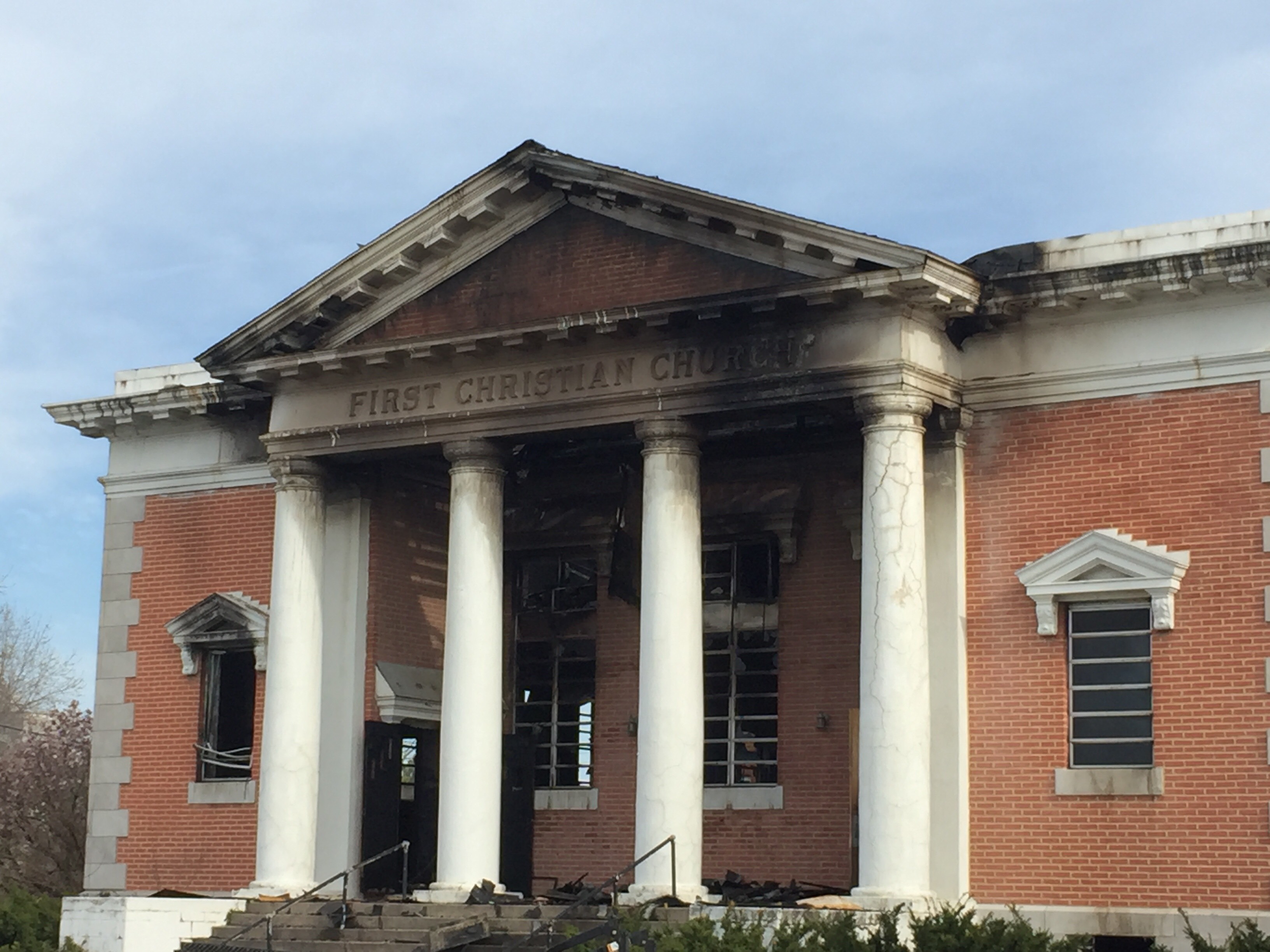A Historic Loss
By Breanna Berry
AURORA, Mo.—As towns become older, the history of their beginnings become preserved in the streets that have been paved and the buildings that have passed the test of time. Aurora has naturally grown over the years, just as every town does, and a little bit of that history is still around even after all these years. Ned Pavlak, a former resident of Aurora, said historic landmarks are important to the residents. “Historic buildings are a good thing to show future generations,” Pavlak said. “They mark a certain time period, help the town stand out with its history and make visitors feel welcomed.”
The First Christian Church, located on 39 West Pleasant Street, is one of the first churches that was built in Aurora when the town was first being established in the 1870s. It served as a haven for its residents, providing services every Sunday for 142 years, until the summer of 2013 when Pastor Charlie Bahn gave his final sermon one Sunday after the church had experienced a continuing decline in memberships and financial resources. The church remained vacant and the town viewed it as a historic landmark, even when a new business moved in called Mirage Pet Products.
Around 6:30 p.m. on Friday, April 6, 2019, a call was made alerting authorities to reports of black smoke bellowing out of the windows of the First Christian Church. As both the Aurora City Fire Department and Aurora Rural Fire Protection District worked to keep the fire under control, surrounding areas such as the Mt. Vernon Fire Protection District, Marionville City Fire Department, Monett City Fire Department and Monett Rural Fire Protection District all provided apparatus and personnel to the scene as the inside of the church was engulfed in flames. Residents throughout the town and outside of town claimed to see the flames and smoke extending upward into the sky as the night went on. Jared Evans, who lives just over a mile from the church, said he could clearly see the flames over the tops of trees and houses. “I knew something was wrong the second I opened my window and smelled smoke,” Evans said. “I stepped outside and there was no way you could miss seeing it.”

Kella Witte, a resident of Aurora for 10 years and the next-door neighbor to the church, was the only one who had to evacuate her home with her family for concerns of the church collapsing and smoke damage. Witte said the entire experience was overwhelming. “It was really sad to see the church like that,” Witte said. “Just knowing that the only thing we could do was just stand there and watch, it was upsetting. I can’t imagine how the owners must feel.” Due to the layout of the building and the extent of the damage, it is hard to say what exactly the cause of the fire was. However, despite this setback and major loss, the Aurora community remains helpful, grateful and hopeful.

http://archives.historymuseumonthesquare.org/detail.php?AccessionNumber=1990-40-2&Q=Aurora
A Big Piece of History for a Small Town
By Breanna Berry

AURORA, Mo.—Aurora might be a small town of just over 7,000 residents, but the history of this old town is what keeps its roots alive. Aurora was officially chartered in May of 1870 by Congregational Minister and former Union Officer Stephen G. Elliott and his wife, Anna. The name of the town also has its connections to Aurora, the Roman Goddess of dawn, and, ironically enough, the new town symbolized a “new dawn” by creating new beginnings for its future residents.
By 1885, the town became fairly established with multiple stores, blacksmiths, wagon makers, a physician, and four churches. However, in November of 1885, a workman ran into rock while digging a well and decided to set off a charge of powder, blowing up pure galena ore. After this discovery, a company was formed to mine in Aurora, leading to more discoveries of galena ore, lead and zinc throughout the area. These discoveries attracted other settlers to Aurora, and, eventually, the Missouri Pacific Railroad building was built to accommodate for more travel and trade. Today, the building stands as the Historical Society and Museum.
As World War I began, the Company M, 2nd Missouri Infantry of Aurora were called to war. Waiting to be sent overseas, the infantrymen came across a stray hound dog they named Winston, that just so happened to accompany them in their travels overseas. Winston returned home with the group, and thus, the Houn’ Dawg mascot was born. He was buried with full military rights long after his return home. Tonya Smith, a long time resident of Aurora, said she is proud to be a full-blooded Houn’ Dawg. “Anyone who has ever lived in Aurora knows the story of our mascot,” Smith said. “Without that story, I don’t think anyone would respect it as much as we do now.”
For Aurora’s Sesquicentennial Celebration and its 150th birthday in 2020, the town’s Centennial Book will be re-released after originally being published in 1970. Kim Mobley, who teaches English/Language Arts & A-Tech for Success at the Aurora High School, wrote the updated introduction for the new release. In the introduction, Mobley gives a brief summary of the history of Aurora, and offers her thanks to Bob Lowry and his Centennial Committee, who compiled and organized the original Centennial Book. “Aurora’s colorful history is anchored in faith, the railroad, mining, industrialization, recreation, agriculture and a fierce loyalty to a Houn’ Dawg mascot, who set the bar for tenacity, determination and grit,” Mobley said.
http://www.auroramochamber.com/index_files/Page400.htm
https://auroramohistoricalsociety.wordpress.com/
Growing a Community

By Breanna Berry
AURORA, Mo.—Aurora, MO, the good ole “Summit City of the Ozarks” and home of the Houn’ Dawgs, is located at the heart of Southwest Missouri, just 31 miles from Springfield in the southwest direction. Aurora may seem like a small, regular town in the Midwest to those who are just passing through, and to some of the folks that live here, they just might agree with that statement. However, no one can deny the numerous amounts of businesses that come and go or have planted down and let this old mining town become their home. Aurora has a variety of restaurants and shops, two gyms, a Walmart, Price Cutter, three Casey’s gas stations, two Dollar General’s, one Dollar Tree, a bowling alley, a drive-in theater, and that is only the beginning of it. Brenda Sanchez, a resident of Aurora and an employee at OACAC Head Start as the Early Head Start Home Visitor, said Aurora is and always will be home to her. “It is a small town, yes, but that’s what makes us such a close community. The more businesses that come in, the more our community grows,” Sanchez said. One of the biggest attractions that many people know Aurora for is the Sunset Drive-in Theater. Opened in 1951, the theater has welcomed many people from not only local areas, but around the country and even across seas. David Marks, the current owner of the theater and former mayor of Aurora, has had the drive-in in his life for 48 years. “Outside of family, the drive-in means everything to me,” Marks said. “I enjoy supplying a large, surrounding area a one-of-a-kind business and seeing people enjoy what we have to offer.”
As far as traditions in Aurora go, the townsfolk always enjoy the events that the seasons bring.
- In March, the Business Expo event is held at the high school where sellers can reserve booths, and for those who come to buy, they take part in giveaways, drawings and door prizes.
- Every June, the town holds the annual “Light the Night” at Baldwin Park, which is an early celebration for the Fourth of July.
- Come October, the annual Aurora Houn’ Dawg Autofest, located at Oak Park, brings locals from all around to have some fun. Beautiful cars, wonderful music, and delicious food makes this fest hard to miss.
- In December, the annual Christmas Parade comes along, where families and friends come together in the cold weather, to celebrate with the warmth in their hearts.
Jared Evans, a resident of Aurora and a current employee at the drive-in, believes these events and businesses are what brings the people together as a community. “I just think that all these events and businesses is what makes Aurora home,” Evans said. “Without all of the people who are involved with making these things happen, what would Aurora be?”
One of the more prominent figures in the community would definitely be Kim McCully Mobley, the English/Language Arts and A-Tech for Success teacher at the Aurora High School. Mobley’s family made Aurora their home after moving here in the 1950s from Arkansas in search for a better life from farming. Her parents, Stan and Faye Estes, did find a good life here and became rich in the process—rich in love, friendship, and embracing all things Houn’ Dawg. Mobley said she is full of Houn’ Dawg pride and keeps the history of Aurora near to her heart. For this, she will always be eternally grateful for the opportunities this small town has presented to her and its people. “All small towns these days have some of the same issues as the big cities. We have poverty and substance abuse incidents on a regular basis. But there is still something special about the Christmas parades, the Car Shows, the school reunions and the fact that when trouble strikes, your community becomes your family,” Mobley said. “I am thankful for being a lifelong Houn’ Dawg. I can’t imagine being anything else.”